CVS Health Bundle
How Does CVS Health Thrive in the Healthcare Industry?
CVS Health, a leading CVS Health SWOT Analysis and a major healthcare company, is reshaping the American healthcare system. It's a powerful force with a strategic focus on integrated care, expanding its services to meet evolving consumer needs. This transformation is evident in its extensive network of retail pharmacies, MinuteClinic locations, and comprehensive health insurance offerings through Aetna.
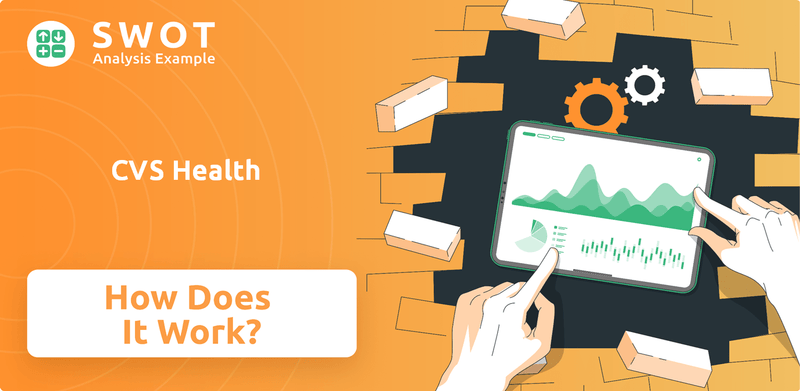
Understanding the inner workings of the CVS company is key to grasping its influence. With its diverse portfolio spanning pharmacy benefits management, retail pharmacy, and health insurance, CVS is uniquely positioned. This in-depth exploration will uncover how CVS Health makes money, its operational strategies, and the challenges it faces in today's dynamic market, providing valuable insights for investors, customers, and industry observers alike.
What Are the Key Operations Driving CVS Health’s Success?
The CVS Health business model revolves around an integrated healthcare approach, providing services across pharmacy, healthcare benefits, and retail operations. This strategy aims to create a seamless and comprehensive healthcare experience for its customers. The company has strategically positioned itself to capture value across the healthcare spectrum, from managing pharmacy benefits to offering health insurance and providing retail pharmacy services.
The core value proposition of CVS Health is to improve health outcomes, enhance customer convenience, and reduce overall healthcare costs. By integrating its various segments, the company aims to create synergies that benefit both consumers and the healthcare system. This integrated model allows CVS to offer a more holistic approach to healthcare, differentiating it from competitors and creating a strong market position.
The company's operations are divided into three main segments: Pharmacy Services, Healthcare Benefits, and Retail/LTC. The Pharmacy Services segment, primarily through CVS Caremark, manages pharmacy benefits, negotiating drug prices and managing formularies. The Healthcare Benefits segment, driven by Aetna, provides health insurance products and services. The Retail/LTC segment operates CVS Pharmacy stores, MinuteClinic walk-in clinics, and Omnicare, which provides pharmacy services to long-term care facilities.
The Pharmacy Services segment, primarily through CVS Caremark, is a key component of CVS Health. This segment handles pharmacy benefits management (PBM), including plan design, administration, and claims processing. It focuses on controlling prescription drug costs and improving health outcomes for plan members. In 2023, the Pharmacy Services segment generated approximately $178.6 billion in revenue.
The Healthcare Benefits segment, mainly through Aetna, provides a wide array of health insurance products and services. These include medical, pharmacy, dental, behavioral health, and disability benefits. This segment serves employer groups, government entities, and individuals. In 2023, this segment contributed roughly $102.9 billion in revenue.
The Retail/LTC segment operates CVS Pharmacy stores, MinuteClinic locations, and Omnicare. This segment offers prescription and over-the-counter medications, health and wellness products, and general merchandise. MinuteClinic provides convenient access to basic healthcare services, while Omnicare offers pharmacy services to long-term care facilities. Revenue for this segment was approximately $114.8 billion in 2023.
The integration of these segments is a key differentiator for CVS Health. For example, the PBM arm (Caremark) influences drug costs, which affects the pharmacies. MinuteClinic locations provide accessible care, often referring patients to other CVS Health services. This integrated approach aims to improve health outcomes, enhance customer convenience, and reduce costs. The company's strategy is designed to create a more connected patient journey.
The synergistic approach of CVS Health aims to provide a comprehensive healthcare experience. The integration of services, such as filling prescriptions, receiving vaccinations, and managing health plans, under one umbrella, enhances customer convenience. This integration is designed to improve health outcomes and reduce overall healthcare costs. For more insights, see Owners & Shareholders of CVS Health.
- Efficient supply chain and distribution networks ensure timely delivery of pharmaceuticals and other products.
- Partnerships with pharmaceutical manufacturers and healthcare providers enhance offerings and operational efficiency.
- MinuteClinic services offer convenient access to healthcare, often referring patients to other CVS Health services.
- The integrated model allows CVS to offer a more holistic approach to healthcare, differentiating it from competitors.
CVS Health SWOT Analysis
- Complete SWOT Breakdown
- Fully Customizable
- Editable in Excel & Word
- Professional Formatting
- Investor-Ready Format
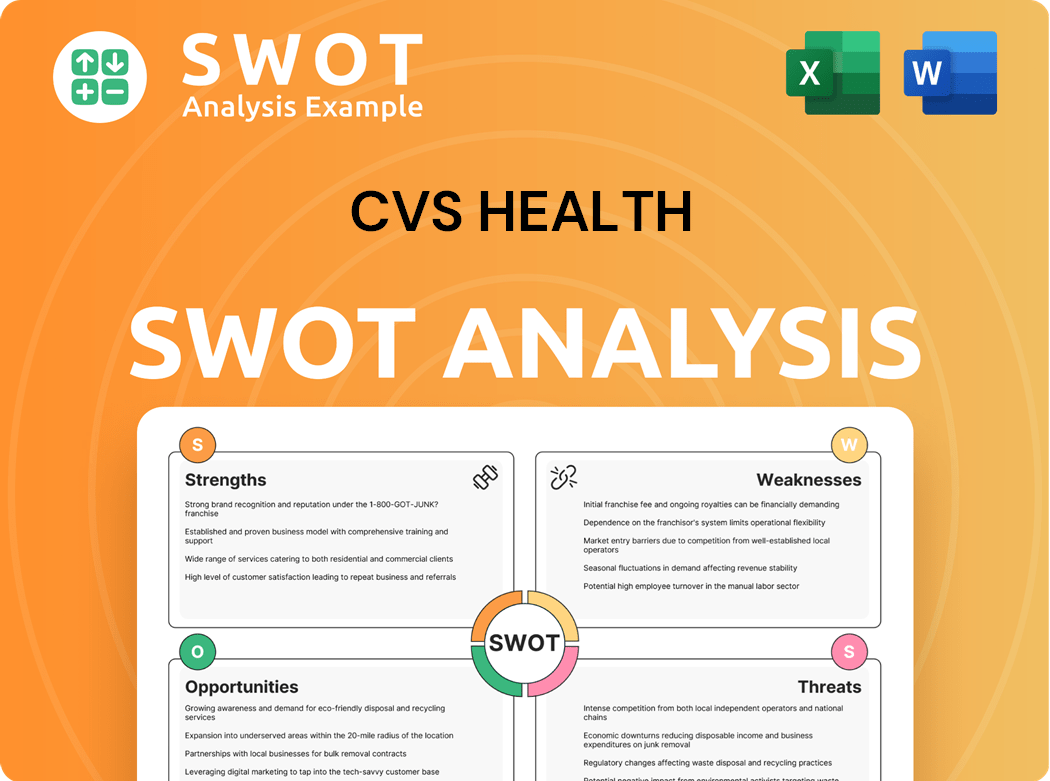
How Does CVS Health Make Money?
The financial success of the CVS Health company is built on a multifaceted revenue model. This model is designed to capture value across the healthcare spectrum, from pharmacy services to health insurance and retail operations. Understanding how CVS generates revenue is key to grasping its market position and growth potential.
CVS's revenue streams are diverse, reflecting its integrated healthcare approach. The company strategically uses various monetization strategies, including value-based care, cross-selling, and tiered pricing models, to maximize revenue and enhance customer engagement. These strategies are essential to its financial performance and its ability to adapt to the changing healthcare landscape.
CVS Health operates through three main segments: Pharmacy Services, Health Care Benefits, and Retail/LTC. Each segment contributes significantly to the company's overall revenue, with distinct strategies and offerings.
The Pharmacy Services segment, primarily through CVS Caremark, generates revenue from various sources. These include administrative fees from pharmacy benefit management (PBM) services, such as claims processing and formulary management. Revenue also comes from the spread between the price charged for prescription drugs and the cost paid to pharmacies and manufacturers.
- Administrative fees from PBM services.
- Revenue from the spread on prescription drugs.
- Formulary management and disease management programs.
The Health Care Benefits segment, mainly through Aetna, earns revenue from health insurance premiums paid by its members. This includes premiums from commercial, Medicare, and Medicaid plans. Additionally, the segment receives administrative services only (ASO) fees from self-funded employers.
- Health insurance premiums from commercial, Medicare, and Medicaid plans.
- Administrative services only (ASO) fees from self-funded employers.
The Retail/LTC segment generates revenue primarily from the sale of prescription drugs and front-store merchandise at CVS Pharmacy locations. Additional revenue streams include MinuteClinic services and long-term care pharmacy services through Omnicare. This segment also benefits from ancillary services like vaccinations and diagnostic testing.
- Sale of prescription drugs and front-store merchandise.
- MinuteClinic services.
- Long-term care pharmacy services (Omnicare).
- Ancillary services such as vaccinations and diagnostic testing.
CVS Health employs several monetization strategies to boost its revenue. One of these is value-based care within Aetna, which ties reimbursement to health outcomes, promoting better patient management and cost efficiency. Cross-selling is another key strategy, where Aetna members are encouraged to use CVS Pharmacies and MinuteClinics. The company also uses tiered pricing models and has expanded into home healthcare services, like the acquisition of Signify Health. For more insights into the customer base, check out the Target Market of CVS Health.
CVS Health PESTLE Analysis
- Covers All 6 PESTLE Categories
- No Research Needed – Save Hours of Work
- Built by Experts, Trusted by Consultants
- Instant Download, Ready to Use
- 100% Editable, Fully Customizable
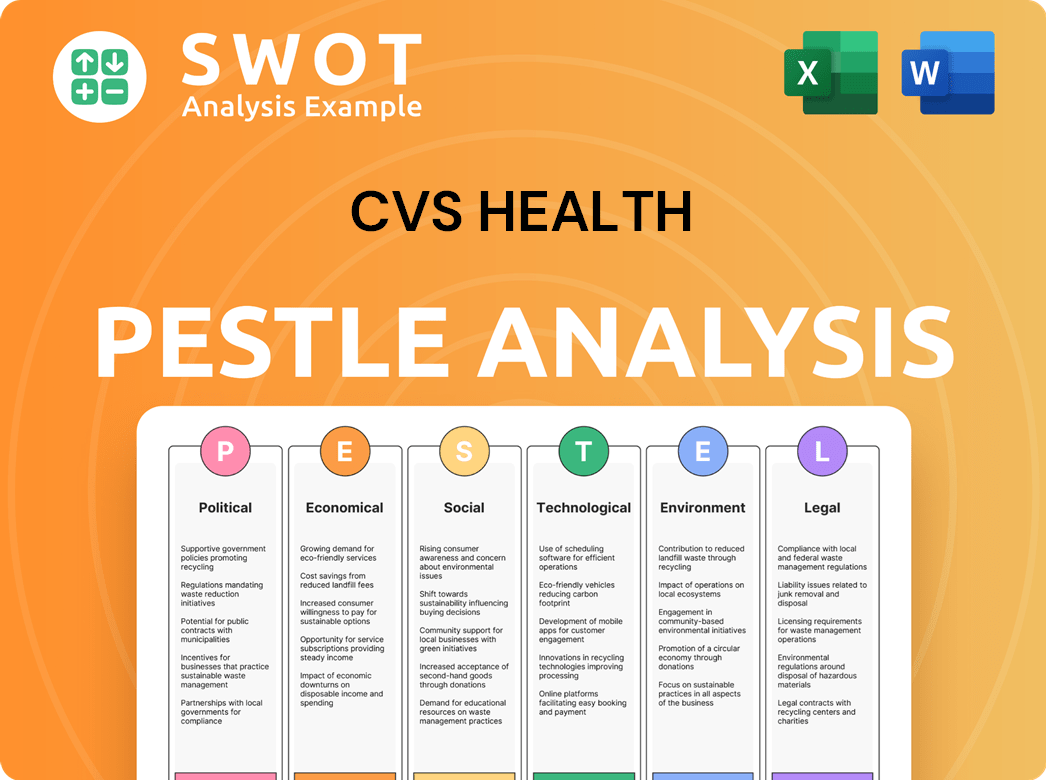
Which Strategic Decisions Have Shaped CVS Health’s Business Model?
The evolution of CVS Health, a prominent healthcare company, has been marked by significant milestones and strategic shifts. These moves have transformed it from a retail pharmacy chain into an integrated healthcare powerhouse. A key turning point was the 2007 acquisition of Caremark Rx, merging a major retail pharmacy with a pharmacy benefits manager, creating CVS Caremark. This initial step set the stage for its integrated model, designed to manage drug costs and improve patient outcomes.
Another pivotal decision was the 2014 move to stop selling tobacco products, accompanied by a rebranding to CVS Health. This underscored its commitment to healthcare and public health, distinguishing it from competitors. The most impactful strategic move was the 2018 acquisition of Aetna for around $69 billion. This brought together a retail pharmacy, PBM, and a major health insurer, creating an integrated healthcare platform. This aimed to control costs, improve care coordination, and enhance patient engagement.
Operationally, CVS has navigated challenges such as evolving regulations, drug pricing pressures, and competition. The company has responded by investing in technology, expanding its MinuteClinic footprint, and developing digital health tools. During the COVID-19 pandemic, CVS rapidly scaled up testing and vaccination capabilities, demonstrating its operational agility and role in public health. For a deeper dive into the company's origins, consider reading Brief History of CVS Health.
CVS Health's competitive advantages are multifaceted, stemming from its scale and integrated model. Its extensive network of retail pharmacies provides unparalleled accessibility. The integration of its PBM, health insurance, and retail pharmacy segments offers a unique value proposition.
In 2024, CVS Health reported revenues of approximately $357.4 billion. The company's pharmacy services segment contributed significantly to this revenue, reflecting its core business operations.
CVS Health continues to focus on key strategic initiatives to maintain its competitive edge. These include expanding its healthcare services, enhancing its digital health offerings, and optimizing its pharmacy benefit management services. These initiatives are designed to improve patient outcomes and drive growth.
CVS Health holds a strong position in the healthcare market. Its integrated model allows it to manage various aspects of patient care, from prescription fulfillment to chronic disease management. This comprehensive approach sets it apart from many competitors.
CVS Health leverages several key strengths to maintain its market position. These include its extensive retail footprint, integrated healthcare services, and strong brand recognition. The company's ability to adapt to changing market dynamics is also a significant advantage.
- Extensive Retail Network: Thousands of CVS locations across the U.S.
- Integrated Healthcare Model: Combining pharmacy, PBM, and health insurance.
- Digital Health Initiatives: Telehealth and personalized health programs.
- Customer Loyalty: Strong brand reputation built over decades.
CVS Health Business Model Canvas
- Complete 9-Block Business Model Canvas
- Effortlessly Communicate Your Business Strategy
- Investor-Ready BMC Format
- 100% Editable and Customizable
- Clear and Structured Layout
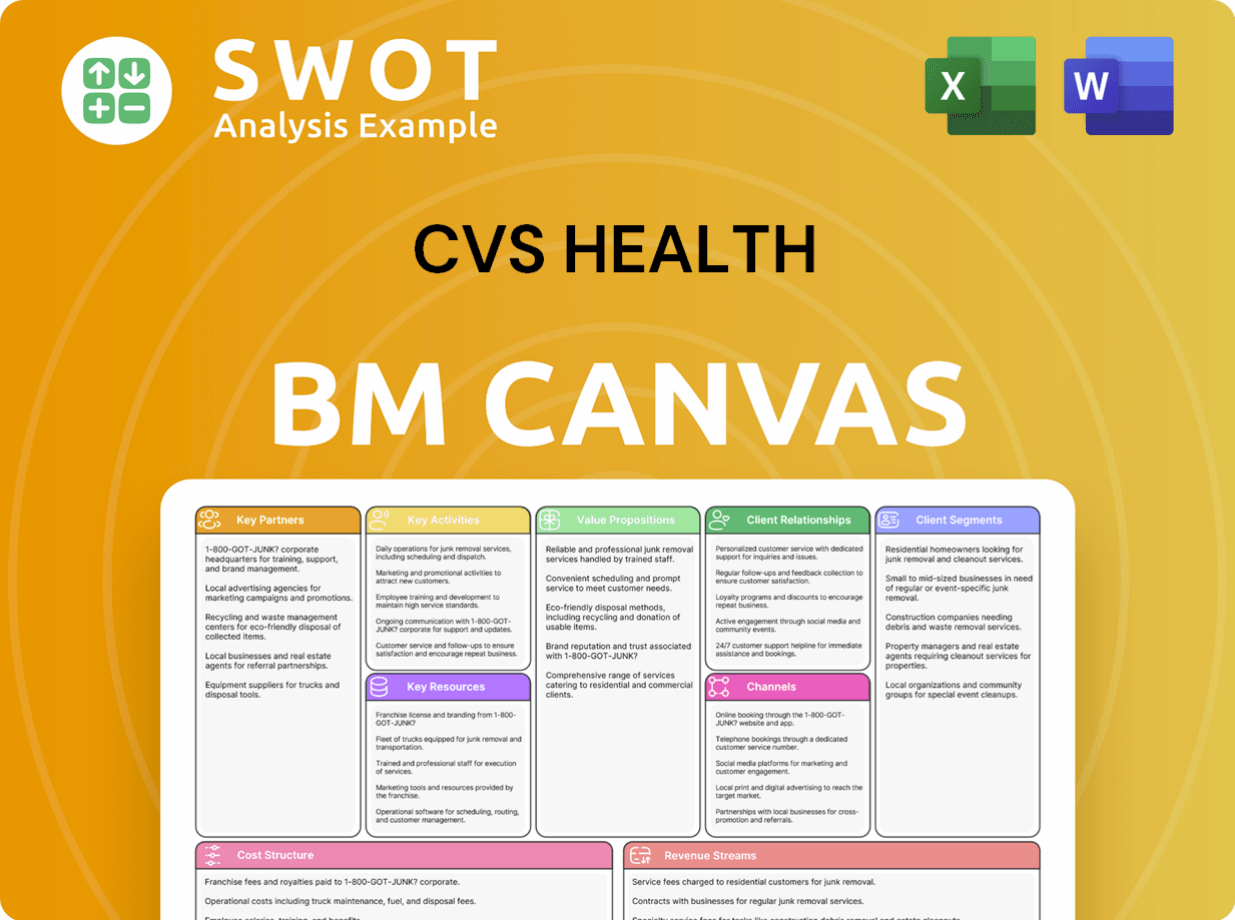
How Is CVS Health Positioning Itself for Continued Success?
CVS Health holds a significant position in the U.S. healthcare sector, functioning as a large, integrated healthcare company. It's a major player in retail pharmacy, pharmacy benefits management (PBM), and health insurance, primarily through its Aetna subsidiary. Its extensive physical presence and established brand contribute to strong customer loyalty. However, the company operates in a dynamic and competitive environment.
The company faces a variety of challenges, including regulatory changes, increased competition, and technological disruptions. The rise of telehealth and evolving consumer preferences require CVS Health to adapt and innovate continuously. The company is actively pursuing strategic initiatives to mitigate these risks and secure its future growth, with a strong focus on primary care and home health. For example, CVS Health's acquisition of Signify Health and Oak Street Health underscores its commitment to becoming a leading provider of value-based care.
CVS Health is a leading healthcare company in the United States, with a strong presence in retail pharmacy, PBM, and health insurance. It competes with major players like Walgreens, Express Scripts (Cigna), UnitedHealthcare, and Anthem. The company's integrated model aims to provide a seamless healthcare experience for consumers.
CVS faces risks from regulatory changes, particularly regarding drug pricing and PBM practices. Increased competition from tech companies and the expansion of existing competitors also pose a threat. Technological disruptions, such as telehealth, and evolving consumer preferences require continuous innovation and adaptation.
CVS Health is focusing on expanding healthcare services beyond traditional pharmacy, with an emphasis on primary care and home health. The company is leveraging data analytics and AI to personalize patient care and improve efficiency. Long-term goals involve deepening its presence in primary care, expanding digital health capabilities, and optimizing existing assets.
In 2023, CVS Health reported revenues of approximately $357.8 billion. The company's pharmacy services segment brought in about $169.8 billion. The health services segment generated around $95.2 billion. The health care benefits segment earned about $284.8 billion in 2023.
CVS Health is investing heavily in primary care and home health services, including acquisitions like Signify Health and Oak Street Health. The company is also expanding its digital health capabilities, leveraging data analytics and AI. These initiatives aim to enhance patient care and drive operational efficiency.
- Focus on value-based care models.
- Expansion of telehealth and virtual care options.
- Integration of pharmacy, benefits, and care delivery assets.
- Emphasis on personalized healthcare experiences.
CVS Health Porter's Five Forces Analysis
- Covers All 5 Competitive Forces in Detail
- Structured for Consultants, Students, and Founders
- 100% Editable in Microsoft Word & Excel
- Instant Digital Download – Use Immediately
- Compatible with Mac & PC – Fully Unlocked
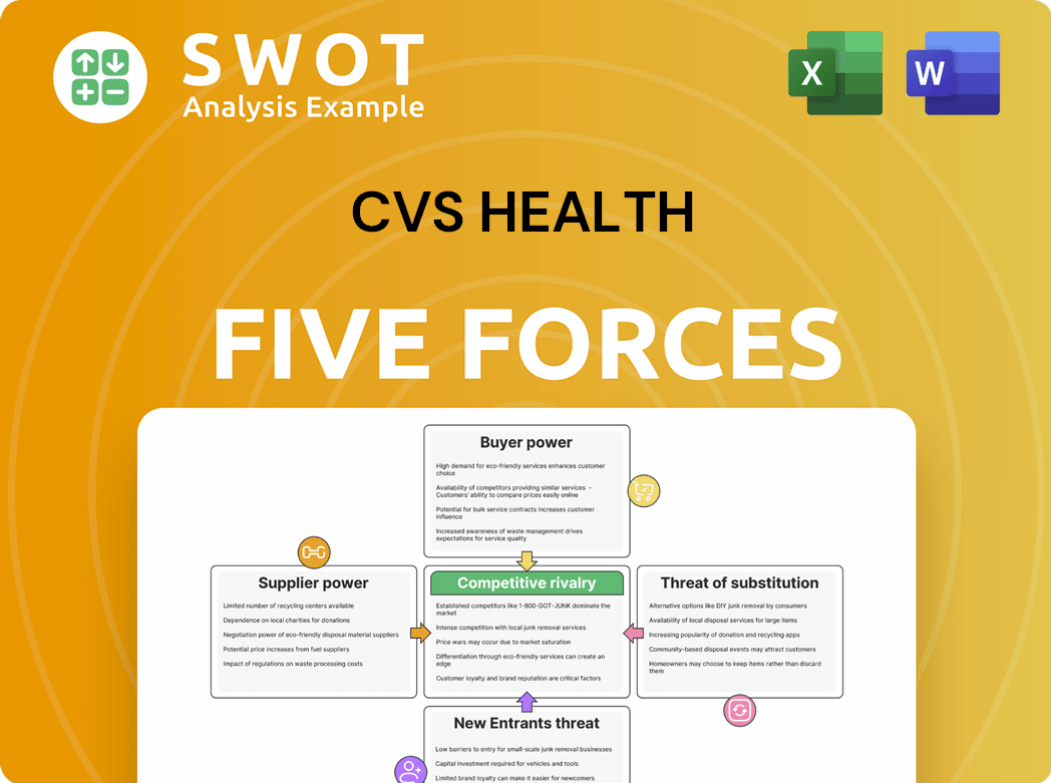
Related Blogs
- What are Mission Vision & Core Values of CVS Health Company?
- What is Competitive Landscape of CVS Health Company?
- What is Growth Strategy and Future Prospects of CVS Health Company?
- What is Sales and Marketing Strategy of CVS Health Company?
- What is Brief History of CVS Health Company?
- Who Owns CVS Health Company?
- What is Customer Demographics and Target Market of CVS Health Company?
Disclaimer
All information, articles, and product details provided on this website are for general informational and educational purposes only. We do not claim any ownership over, nor do we intend to infringe upon, any trademarks, copyrights, logos, brand names, or other intellectual property mentioned or depicted on this site. Such intellectual property remains the property of its respective owners, and any references here are made solely for identification or informational purposes, without implying any affiliation, endorsement, or partnership.
We make no representations or warranties, express or implied, regarding the accuracy, completeness, or suitability of any content or products presented. Nothing on this website should be construed as legal, tax, investment, financial, medical, or other professional advice. In addition, no part of this site—including articles or product references—constitutes a solicitation, recommendation, endorsement, advertisement, or offer to buy or sell any securities, franchises, or other financial instruments, particularly in jurisdictions where such activity would be unlawful.
All content is of a general nature and may not address the specific circumstances of any individual or entity. It is not a substitute for professional advice or services. Any actions you take based on the information provided here are strictly at your own risk. You accept full responsibility for any decisions or outcomes arising from your use of this website and agree to release us from any liability in connection with your use of, or reliance upon, the content or products found herein.